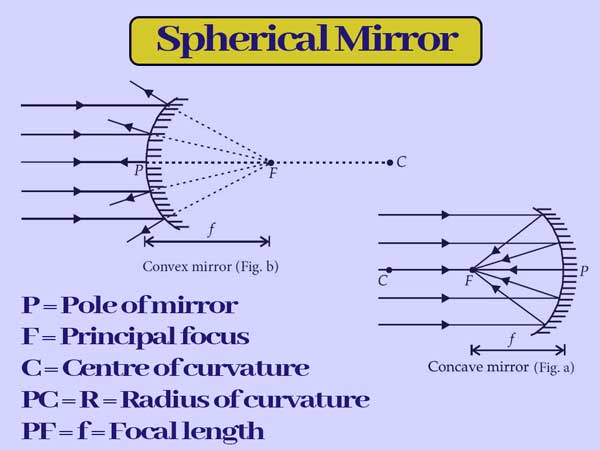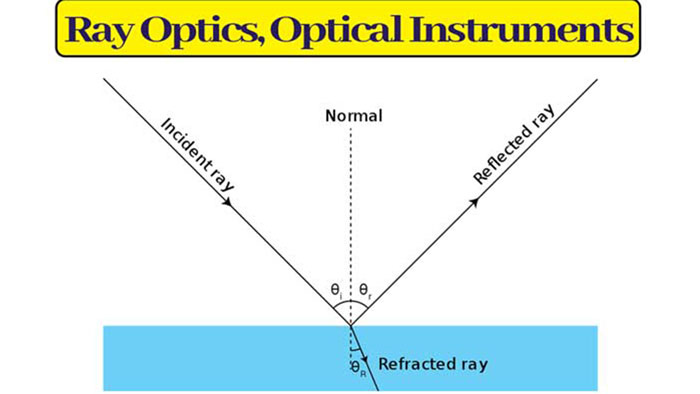Understanding Ray Optics and Optical Instruments: A Comprehensive Guide
Optics
Ray Optics and Optical Instruments: It is the branch of physics that deals with the study of light and the phenomena associated with it. It is divided into two branches:
- Geometrical optics or ray optics
- Physical optics or wave optics
Geometrical optics or ray optics: It treats propagation of light in terms of rays and is valid only if the wavelength of light is much lesser than the size of obstacles. It deals with the formation of images by ordinary geometrical methods and the laws of reflection and refraction.
Physical optics or wave optics: It deals with the theories of the nature of light and provides an explanation for different phenomena like reflection and refraction on the basis of Huygens principle, interference, diffraction, and polarisation.
Lection of light:
When a light ray strikes the surface separating two media, a part of it gets reflected i.e. returns back in the initial medium.
It is known as reflection. The angles which the incident ray and the reflected ray make with the normal to the surface are known as the angles of incidence and angle of reflection respectively.
Laws of reflection of light:
The two laws of reflection of light are as follows:
– The incident ray, the reflected ray and the normal to the surface, all lie in the same plane.
– The angle of incidence i is equal to the angle of reflection r. i.e. i = r

When light is reflected from a denser medium surface, there occurs a phase change of p but no phase change occurs if it is reflected from a rarer medium surface.
On reflection, the velocity, wavelength, and frequency of light do not change. But the amplitude or intensity of the reflected ray is less than that of the incident ray.
Reflection by a plane mirror: The focal length and radius of the curvature of the plane mirror are infinite.
The image formed by the plane mirror is at the same distance behind the mirror as the object is in front of it. The image formed by the plane mirror is always erect, virtual and of the same size as the object.
If the mirror moves away or towards an object by a distance d, then the image moves away or towards the object by a distance 2d.
If the mirror moves with speed v towards or away from fixed object, then image appears to move towards or away from the object with speed 2v.
Spherical Mirror:
A spherical mirror is part of a spherical reflecting surface. A spherical mirror is of two types:
Concave mirror: When the reflection takes place from the inner surface and the outer surface is polished, the mirror is known as a concave mirror. As shown in fig. (a).

Convex mirror: When the reflection takes place from the outer surface and the inner surface is polished, the mirror is known as a convex mirror. As shown in fig. (b).
Sign conventions
– All distances have to be measured from the pole of the mirror.
– Distances measured in the direction of incident light are positive, and those measured in the opposite direction are taken as negative.
– Heights measured upwards and normal to the principal axis of the mirror are taken as positive, while those measured downwards are taken as negative.
Refraction of light: When a ray of light passes from one medium to another, in which it has a different velocity, there occurs a change in the direction of propagation of light except when it strikes the surface of separation of two media normally. This bending of a ray of light is known as refraction.
The angles made by the incident ray and the refracted ray with the normal to the separating surface at the point of incidence are known as the angles of incidence and of refraction respectively.
Laws of refraction:
The two laws of refraction are as follows:
– The incident ray, the normal and the refracted ray all lie in the same plane.
– The ratio of the sine of the angle of incidence to the sine of the angle of refraction for any two media is constant for a light of definite color. This constant is denoted by 1μ2 or μ21 called the refractive index of the second medium with respect to the first, the subscripts 1 and 2 indicating that the light passes from medium 1 to medium 2.
Some natural phenomena due to sunlight
Rainbow: Rainbow is a beautiful arc of seven colours seen in the sky after rainfall. The rainbow is an example of the dispersion of sunlight by the water drops in the atmosphere. This is a phenomenon due to combined effect of dispersion, refraction and reflection of sunlight by spherical water droplets of rain. To observe the rainbow, back of observer must be towards the sun.
Scattering of light: As sunlight travels through the earth’s atmosphere, it gets scattered (changes its direction) by the atmospheric particles. Light of shorter wavelengths is scattered much more than light of longer wavelengths. The amount of scattering is inversely proportional to the fourth power of the wavelength. This is known as Rayleigh scattering.
Illustrations of scattering of light
– Blue colour of sky
– White color clouds
– The sun looks reddish at the time of sunrise and sunset
– Danger signals are red.
Defects of the eye: Defects of the eye are mainly of four types :
– Myopia
– Hypermetropia
– Presbyopia
– Astigmatism
